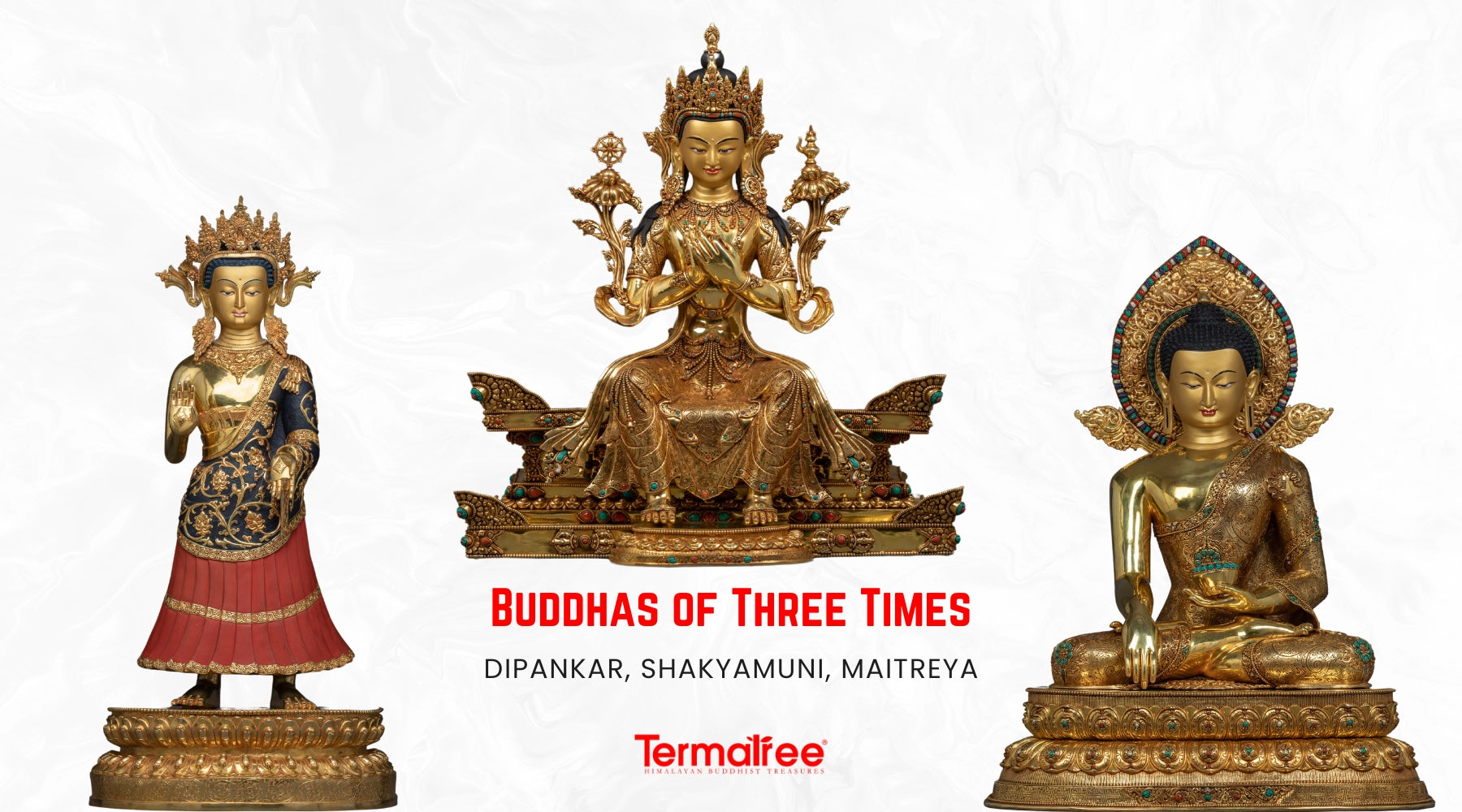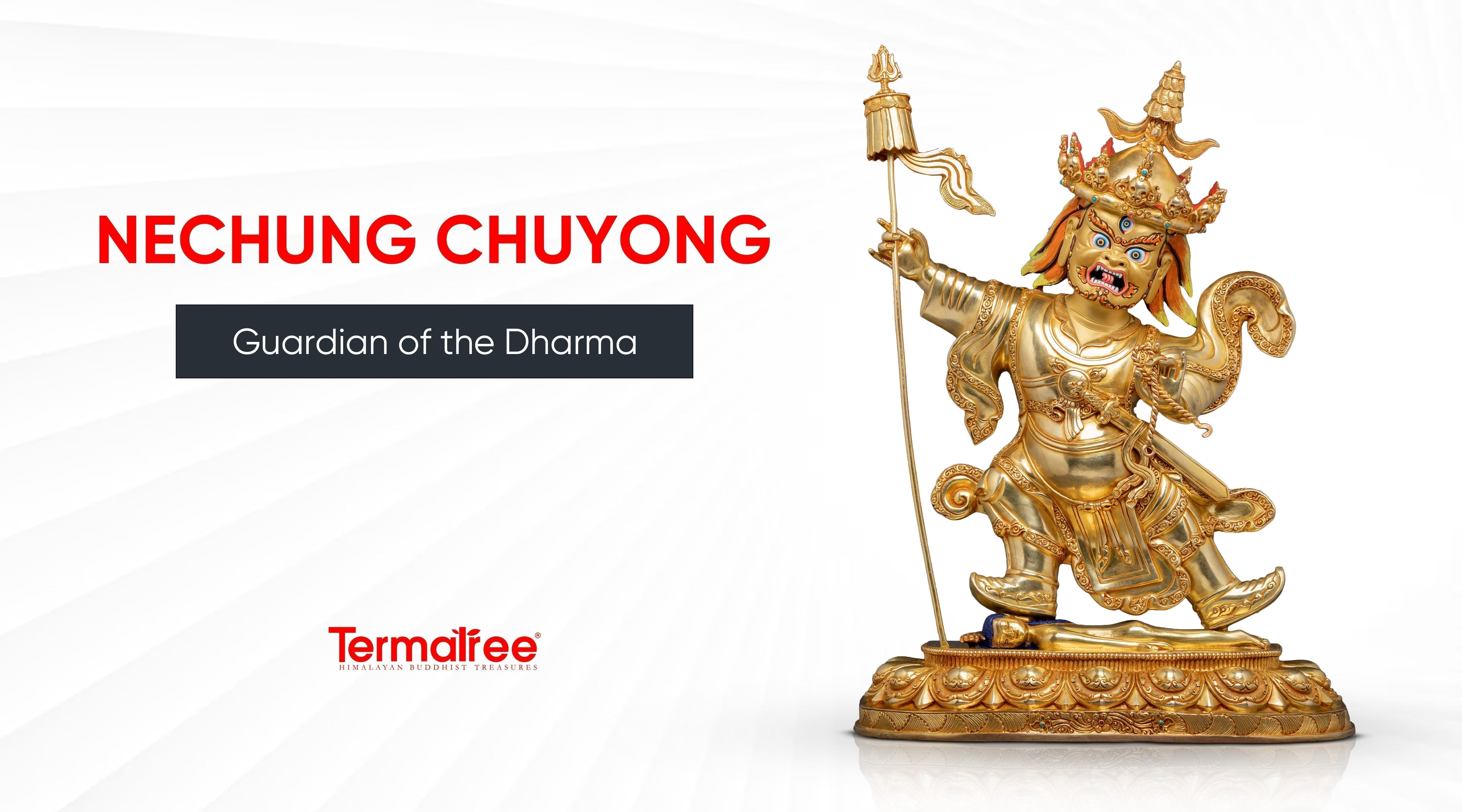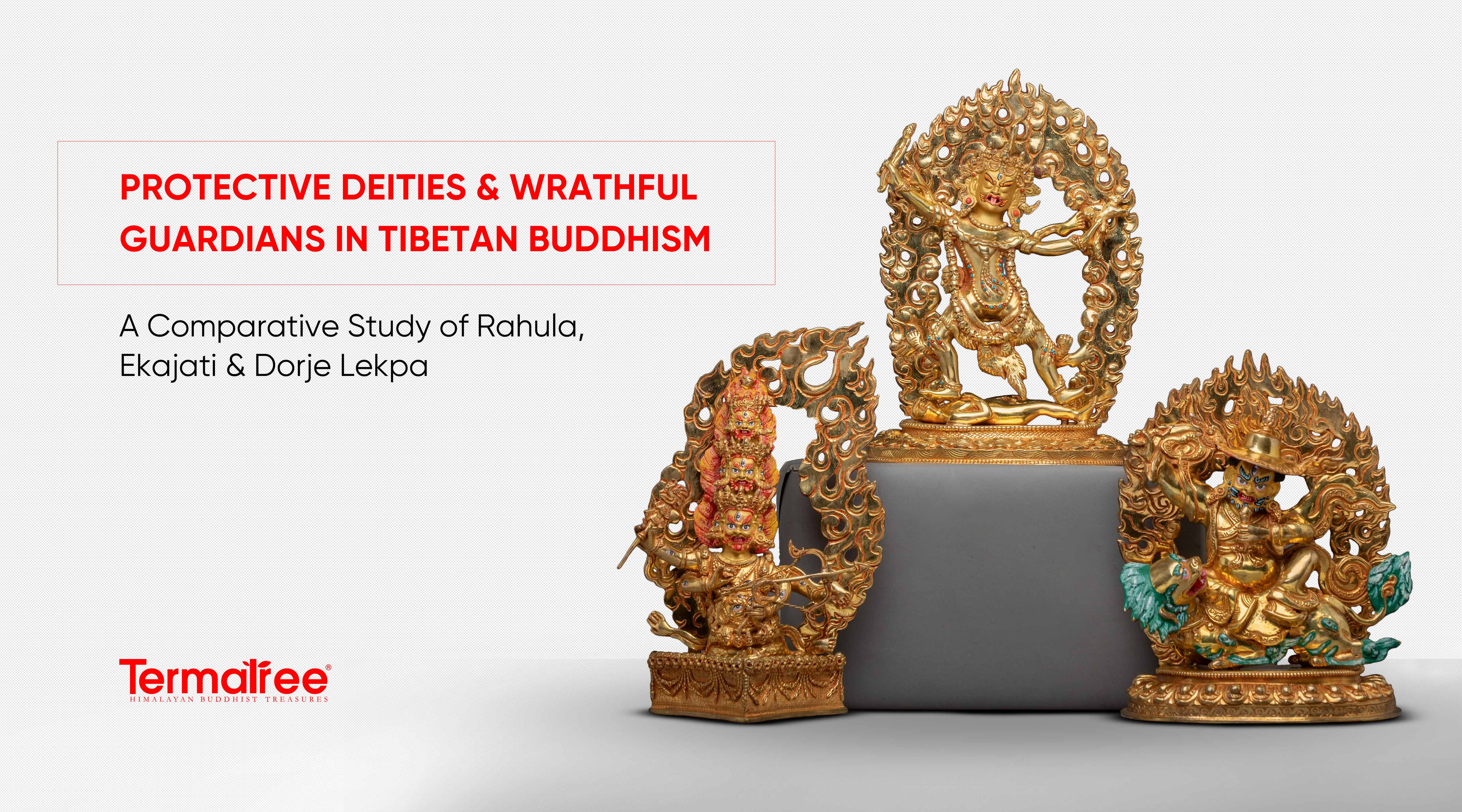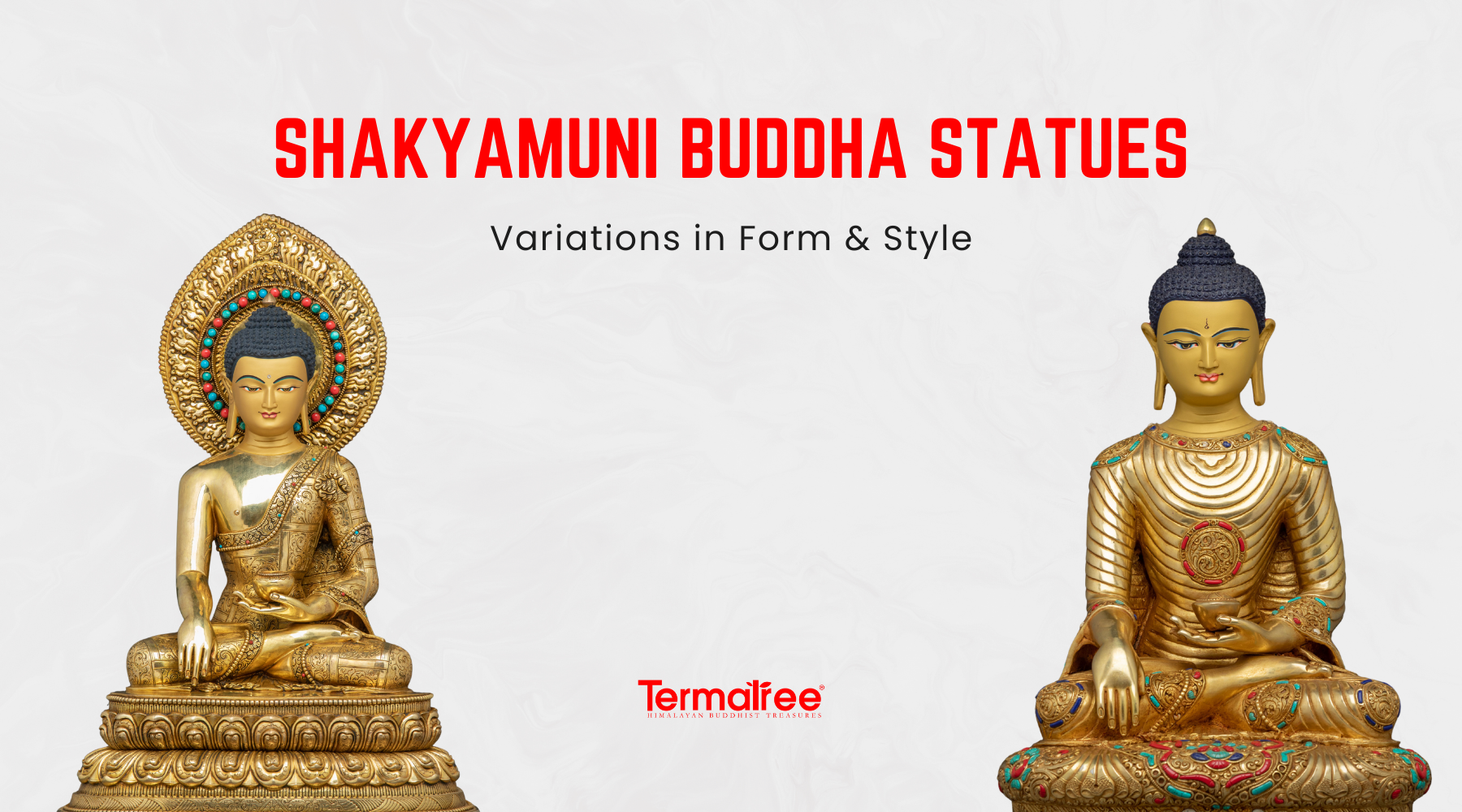From Dipankara to Maitreya: The Timeless Journey of Enlightenment
Both Mahayana and Vajrayana Buddhism honor three enlightened Buddhas of Dipankara in the past and Shakyamuni in the present, along with Maitreya, who will appear in the future. Dipankara Buddha stands for the original enlightenment that first showed the path of Dharma before Shakyamuni Buddha appeared during this era to transmit essential teachings about liberation and Maitreya Buddha will come in the future to embody full enlightenment.
These three Buddhas create a holy trinity that defies temporal boundaries to demonstrate that the Dharma emerges repeatedly when enlightenment is needed to show ordinary beings the path to liberation. From artistic representations to scripture and meditation practice, one can witness the eternal and ever-renewed path to enlightenment that belongs to all seekers of their true Buddha nature.
Understanding the Buddhas of the Three Times
A Sacred Continuum
The Three Buddhas of Time, Dipankara, Shakyamuni, and Maitreya, function beyond their mythological historical roles. These Buddhas create a living energetic bridge that shows the eternal process of spiritual enlightenment. The Buddhist cosmological view uses time as a cycle that extends indefinitely through endless universe clusters as various Buddhas appear to help beings find liberation. Through the fulfillment of the Dharma, one can participate in this living spiritual cycle.
The three Supreme Buddhas demonstrate different spiritual development levels:
-
Dipankara represents the original enlightenment, inspiration, and divine blessing.
-
Shakyamuni embodies the recognized enlightened soul and the present master.
-
Maitreya stands for the fulfillment of the coming age and universal love.
The combination of these Buddhas displays Dharma's everlasting significance to all beings. The succession of Buddhas proves enlightenment occurs throughout all dimensions, including space-time and consciousness simultaneously.
Let’s explore each of these individual divinities in more depth below:
Dipankara Buddha: Illuminator of the Infinite Past
The Ancient Buddha of Light

Within Buddhist tradition, the master of light and bearer of light, known as Dipankara Buddha, exists as one of the earliest recognized Buddhas. Buddha Dipankara established himself numerous cosmological periods prior to the present cosmic age, making him an object of veneration as the one who foretold Shakyamuni Buddha's arrival. Many of his stories derive from Jataka tales, particularly the well-known story about Sumedha the Hermit, who later became Siddhartha Gautama before his enlightenment as a Buddha after meeting Dipankara.
Dipankara passed through a muddy path while Sumedha placed his own hair across the ground so that the holy being would not become dirty. The act of unselfishness in laying his hair down for Dipankara's path moved the Buddha to predict that Sumedha would become a Buddha in an age to come.
Iconography and Symbolism
In most depictions of Dipankara, the Buddha stands while radiating light through his body, wearing the robes of a Buddhist monk. The mudras performed by him include:
-
Abhaya Mudra (right hand raised): Extending protection and fearlessness.
-
Varada Mudra (left hand downturned): Symbolizing both generosity and blessing.
Dipankara stands unlike Buddhas who typically rest in meditation which expresses his duty to initiate religious journeys. The spiritual being of Dipankara emits serenity through his peaceful expression which frequently accompanies golden radiant energy.
In Himalayan thangkas and statues one can typically find Dipankara Buddha positioned to the left of Shakyamuni while representing the earliest origin of teachings known as the Dharma.
Spiritual Significance
Enlightenment exists as a beginningless phenomenon, which Dipankara Buddha represents despite his status as a historical figure of the past. Practitioners receive inspiration from his stories to develop the bodhisattva vow through understanding that every single devout action will reverberate across multiple lifetimes.
Through his place in the Three Times depiction, we remember that our roots in awakening extend back through countless lifetimes, and true devotion makes our spiritual blossoming possible today.
Shakyamuni Buddha: Awakened Guide of the Present
The Historical and Spiritual Master

The sage of the Shakya clan, Shakyamuni Buddha, came into existence as Prince Siddhartha Gautama during the 6th century BCE in Lumbini, Nepal. After abandoning his noble position, Siddhartha performed years of dedicated meditation under the Bodhi Tree at Bodhgaya until he reached enlightenment.
The teachings that guide us within this present spiritual age come from Buddha of the Present Aeon. The first teaching cycle at Sarnath marked a spiritual transformation which Shakyamuni Buddha established to spread worldwide religious impact.
The life of Shakyamuni serves as an example meaningful for all humanity to demonstrate the journey which transforms people from ignorant comfort to enlightened compassion. Within Tibetan and Himalayan art tradition Shakyamuni portrays vajrasana (lotus posture) on dual lotus throne to symbolize his mastery over dualistic nature. His figure expresses both tranquility and lucidness combined with firm resolve.
Major visual symbols of Shakyamuni Buddha consist of:
-
Mudra (Hand Gesture): With his right hand, Shakyamuni reaches toward the ground, making the bhumisparsha mudra (earth-touching gesture) to call the earth as witness of his enlightenment. At this moment, Shakyamuni proves victorious over Mara, who represents ignorant forces and desire, and creates a symbol for spiritual awareness and satisfaction.
-
Alms Bowl: His left hand maintains the begging bowl (pātra) with its contents filled either with nectar or medicinal herbs which sits on his lap. The bowl shows the essence of monasticism through its depiction of simplicity as well as the renunciative lifestyle.
-
Physical Features: Shakyamuni’s body bore 32 major and 80 minor marks of a Buddha, including:
-
Golden-hued skin, signifying the purified physical state.
-
A calm expression that expresses tranquility.
-
Long earlobes reveal his royal lineage with his abandonment of temporal wealth.
-
A tuft of hair (ūrṇā) between the eyebrows represents spiritual insight.
-
The ushnisha represents supreme wisdom.
The illustrative depiction of Shakyamuni focuses on teaching that enlightenment reaches people who actively work to discipline themselves and maintain moral integrity. Shakyamuni represents both the highest teacher and the perfect example of self-evolution.
Profound Teachings
Every Buddhist tradition draws its foundation of teachings from the key lessons delivered by Shakyamuni Buddha:
-
The Four Noble Truths: Suffering, its origin, cessation, and the path.
-
The Noble Eightfold Path: Right view, intention, speech, action, livelihood, effort, mindfulness, and concentration.
-
Dependent Origination (Pratītyasamutpāda): All phenomena exist through interdependence.
Through his teaching Shakyamuni imparted the three marks of existence which consist of impermanence (anicca) suffering (dukkha) and non-self (anatta) that directed practitioners to develop mindfulness include ethical conduct and meditative insight.
Time has no power to diminish the ongoing importance of Shakyamuni’s teachings which retain their same strength after 2,500 years. Through sutras as well as silence and the fellowship of the Sangha his teachings continue to be heard.
Maitreya Buddha: The Compassionate Promise of the Future
The Coming Buddha

Future Buddha Maitreya holds the names “The Friendly One” and “Loving Kindness” as he will appear after Shakyamuni’s teachings disappear. The cycle of teachings is something Maitreya awaits in Tushita Heaven during his waiting period for a suitable moment to descend and spread Buddhism again.
Maitreya serves as the spiritual symbol of global compassion through which he will establish a new enlightened era of human consciousness. The teachings of enlightenment continue to unfold and regenerate through His predicted arrival.
Unique Iconography
His iconographic traits include:
-
Seated Western Style (Pralambapadasana): Maitreya occupies a throne with lowered legs like a normal human being because he is ready to act in the world. The imagery represents his future action powerfully.
-
Hand Gestures and Implements:
-
He reveals his future teaching through the dharmachakra mudra, the gesture of turning the Wheel of Dharma.
-
With his hand, he may hold the stems of lotuses, which elevates to his shoulders. A water flask (kundika) rests with the Wheel of Dharma (Dharmachakra) on top of the lotuses which extend from his hands.
-
The water flask carried by Maitreya demonstrates purification power and symbolizes longevity, just as his Wheel represents the importance of his teaching role.
-
Ornamentation: Maitreya distinguishes from Shakyamuni through his outfit of ornamented bodhisattva attire because his role and abundant merit require such lavish adornment including jeweled crown, earrings, necklaces and armlets, and silken scarves.
-
Heavenly Realm: Religious traditions indicate that Maitreya currently dwells in the Tushita Heavenly Realm but will come to Earth upon decay of Shakyamuni’s teachings. A large number of thangkas and sculptures depict this event through representations of heavenly beings who bow before Maitreya.
Through his visual representation, Maitreya provides inspiration for both a global salvation scenario and the inevitable manifestation of wisdom and love in every human being. The Dharma exists as an eternal force of compassion because it continues to light the way even beyond the current and previous moments of time.
Maitreya's Age and Future Teachings
The Maitreya-vyākaraṇa and Anāgatavaṃsa visionary writings predict that Maitreya's upcoming age will introduce exceptional shifts to human life span and natural processes. Human life expectancy at that possible age will extend to an extraordinary period of eighty-four thousand years, where people can progressively develop knowledge alongside compassion through many generations of sustained education. The rise of Maitreya will create society's most harmonious state through resource equity, reduced conflicts, and widespread goodwill between community members. Through Maitreya's excellent leadership, the Dharma will fully revive from its potential extinction while its wisdom will boost powerfully throughout all aspects of existence.
Maitreya will introduce the scriptures' “Threefold Pure Dharma” instead of following the established paths of previous Buddha figures during this spiritual revival period. This new age combines the highest ethical standards with deep meditation along with wisdom that sees the Buddha-nature essence within each person. His compassionate work will rapidly lead countless living beings to liberation because his actions destroy old obstructions and spark new spiritual aspirations in the collective heart. Maitreya's future age establishes enduring positive expectations along with the birth of universal spiritual understanding as a demonstration that compassionate light endures through eternity to bring enlightenment to humanity.
Devotion to Maitreya Today
Many devotees ask Maitreya Buddha for three things:
-
The swift return of Dharma in times of decline.
-
The cultivation of loving-kindness (maitri) in daily life.
-
The inspiration to join the future lineage of spiritual awakening.
Maitreya's mantra Om Maitreya Maha Maitreya Arya Maitreya Soha serves as practitioners' common method to receive his divine blessings and establish spiritual connections for the future.
The Three Buddhas in Himalayan Art and Practice
Sacred Triads and Visualization
You can find the Three Time Buddhas, Dipankara, Shakyamuni, and Maitreya, depicted as a religious grouping in paintings and statues from Himalayan Vajrayana Buddhism. The arrangement of these Buddhas appears throughout thangka paintings, bronze statues, and temple murals.
-
Dipankara on the left (representing the past)
-
Shakyamuni in the center (representing the present)
-
Maitreya on the right (representing the future)
The particular placement reveals much more than symbolic value. Through the depiction the Dharma's timeless continuity the visual meditation space welcomes people to contemplate their position regarding the eternal Dharma. The artistic design utilizes three elements in a shape that depicts an ongoing cyclic pattern to help practitioners eradicate the false sense of distance between past present and future.
During Vajrayana meditation, practitioners simultaneously visualize all three Buddhas. Through this practice, the practitioner embodies different time measurements of spiritual development:
-
Dipankara: Radiates the purity and momentum of ancient aspirations.
-
Shakyamuni: Grounds the practitioner in mindfulness, discipline, and ethical conduct.
-
Maitreya: Inspires to develop selfless intentions that guide to a more enlightened future.
By activating this visualization, practitioners establish an active mandala of realization that links them to all enlightened lineages at the same time as it generates within them the qualities of enlightenment.
Symbolic Meaning for Practitioners
They function to do more than pay reverence when the Three Buddhas appear visually in practice, on altars, or during contemplative meditation. Spiritual development features three central dimensions, which the three Buddhas represent distinctly:
-
Purification (Dipankara):
Cognition of Dipankara functions to eliminate the karmic residues which accumulated across past lives. The ancient light of his presence links practice to spiritual vows and virtues as well as lifetimes of accumulated momentum. Ritual practices use his invocation to remove obstructions while rebooting the profound mind of enlightenment (bodhicitta). -
Stabilization (Shakyamuni):
Through meditation on Shakyamuni, a person can develop mindfulness while achieving moral clarity in their everyday experience. The central position of Shakyamuni represents his essential task of teaching Dharma to all beings on Earth. The earth-feet touch of his body activates disciplined moment-to-moment changes toward enlightenment. -
Aspiration (Maitreya):
Prayers to Maitreya help people develop a compassionate vision for the future while harboring endless optimism. The prophecy about his return symbolizes that the Dharma will never stop coming back to the world. His teachings motivate believers to create an existence structured by loving-kindness along with wisdom.
The complete code for spiritual awakening comes from these three Buddha manifestations. Metaphysical interaction with all three Buddhas provides practitioners with these benefits.
-
The rhythm of Dharma presents itself when one transcends linear timeframes.
-
They should see their life path connect with the eternal sequence of spiritual enlightenment that spans across time.
-
The constant path of purification progresses toward stabilization and ends in expansive aspiration to create a temple that grows stronger through each phase of mindful action.
Through this three-part practice we can activate the sacred qualities of the Buddhas which emerge inside ourselves to transmit Dharma to other sentient beings.
Conclusion: A Timeless Journey Through Enlightenment
The contemplation of Dipankara, along with Maitreya and Shakyamuni, brings us to understand that Dharma extends across all times, resulting in three universal teachers. Awakened mind manifests through uninterrupted clarity as an ever-unfolding expression between the past, present, and future. The ancient path receives its initial rays of enlightenment when Dipankara appears as the first Buddha to illuminate this path which extends before and after our current lifetime. Through his deep connection to reality, Shakyamuni gives modern people important spiritual insights for their present needs and aspirations by proving that freedom from suffering is both essential and innate to them. The radiant promise from Maitreya guarantees that Dharma will emerge as a higher vision of enlightenment even though darkness dominates the times.
All three Buddhas exist as approachable beings whom human beings can honor and respect closely. The Buddhas reflect back the complete strength we can achieve. Through holy stories and sacred symbols, their existence serves as an affirmative route to their illuminated way of living. Meditation, along with mantra and visualization, and devotion practices, allows us to transform ourselves into the eternal qualities which the Buddhas represent. The pathway of their accomplishment becomes accessible to us so we can develop the same understanding and compassion that dwells within our hearts.
People frequently switch between forgetting important matters, while the Buddhas of the Three Times serve as radiant reference points. Life presents us with endless opportunities to awaken through the present moment, so we should remember this fact instead of viewing it as something distant or beyond our reach. Through our practice and daily lives, we maintain the sacred Dharma trajectory by bringing the same enlightenment that Dipankara experienced, that Shakyamuni experienced, and Maitreya will display in the future.





1 comment
🔊 Notification- Operation 1,568287 BTC. Get >> https://graph.org/Ticket--58146-05-02?hs=6343e9f695394910375f464adb5f7719& 🔊
mdvc6l